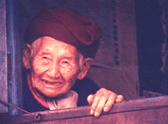MYANMAR INFORMATION
Where is Myanmar?
Surely by now, that we are in the 21st century, half of the world will have been renamed. Old countries with new names appear all over Africa and Asia. Since1989, Burma has become Myanmar and its capital, Rangoon, has become Yangon, Pegu has become Bago, Maymyo has become Pyin-Oo-Lwin, and so on. Myanmar, also known as the Golden Land, not only for its golden pagodas but also for the wealth of its agriculture and its precious minerals is - with its total area of 676,577 square km - about the size of the United Kingdom and France combined. It lies in South East Asia, with parts of India and Bangladesh to the west, China to the north and Laos and Thailand to the east. Its southern borders are formed by the sea; by the Bay of Bengal to the southwest and the Andaman Sea to the southeast. However, whatever you call it, Myanmar or Burma, as Somerset Maugham once wrote: "You try to guard yourself by saying it is not real... it is a beauty that batters you and stuns you and leaves you breathless..."


People
The population of Myanmar, spread over seven states and seven divisions, is estimated at 51 million people (acc to census 2014). Myanmar is inhabited by 135 ethnic nationalities. The Bamars, comprising about 69 % of the population, form the largest group.
Religion
Theravada Buddhism is the predominant religion, with 80 percent of the population embracing it. There are also Christians, Muslims and Hindus.
Culture
Buddhism has great influence on daily life of the Myanmars. The people have preserved tradition of close family ties, respect for the elders and reverence for Buddhism. Myanmars are known for their hospitality and friendliness.
History
Myanmar, formerly known as Burma, is recognized by the world as the Golden Land. It is one of the earliest homes of mankind, where one can have exclusive experiences of a life-time.
Myanmar’s Golden Age dates back to the 11th century when King Anawrahta united the whole country into the First Myanmar Empire in Bagan well before the Norman conquest of England in 1066. The Bagan Empire encompassed the entire Menam valley in Thailand and lasted about 250 years, before it collapsed with the invasion of the Mongols under the leadership of Kublai Khan in the 13th century. The Second Myanmar Empire was founded in the middle 16th century by King Bayinnaung. King Alaungpaya founded the Third Myanmar Empire in 1752. It was during the zenith of the Konbaung dynasty, that the British colonized Myanmar.
Britain conquered Burma over a period of 62 years (1824-1886) and incorporated it into its Indian Empire. Burma was administered as a province of India until 1937 when it became a separate, self-governing colony; independence from the Commonwealth was attained in 1948.
On January 4, 1948 at 04:20am, the nation became sovereign, as the Union of Burma, with U Nu as the first Prime Minister. Democratic rule ended in 1962 with a military coup d'état led by General Ne Win. Ne Win ruled for nearly 26 years, bringing in harsh reforms. In 1990 free elections were held for the first time in almost 30 years, but the landslide victory of the NLD, the party of Aung San Suu Kyi was voided by the military, which refused to step down.
One of the top figures in Burmese history in the 20th century is Army founder and freedom figure General Aung San, a student-turned activist whose daughter is 1991 Nobel Peace Laureate and worldwide peace, freedom and democracy icon Aung San Suu Kyi of the NLD, now under house arrest. The third most recognized Burmese figure in the world is U Thant, who was UN Secretary General for two terms and highly respected throughout United Nations' history.
In November 2005, the military junta announced that the national capital would be moved from Yangon to Pyinmana, and since we have Naypidaw as a capital.



Language
Burmese is the mother tongue of the Bamar and official language of Burma, is related to Tibetan and Chinese. It is written in a script consisting of circular and semi-circular letters, adapted from the Mon script. The earliest known inscriptions in the Burmese script date from the 1000s. In villages, secular schooling often takes place in monasteries.









